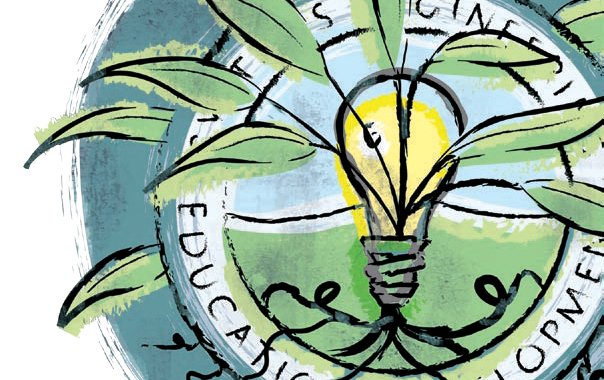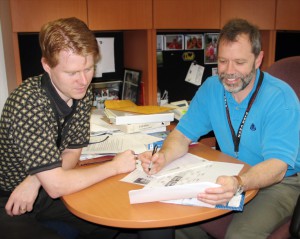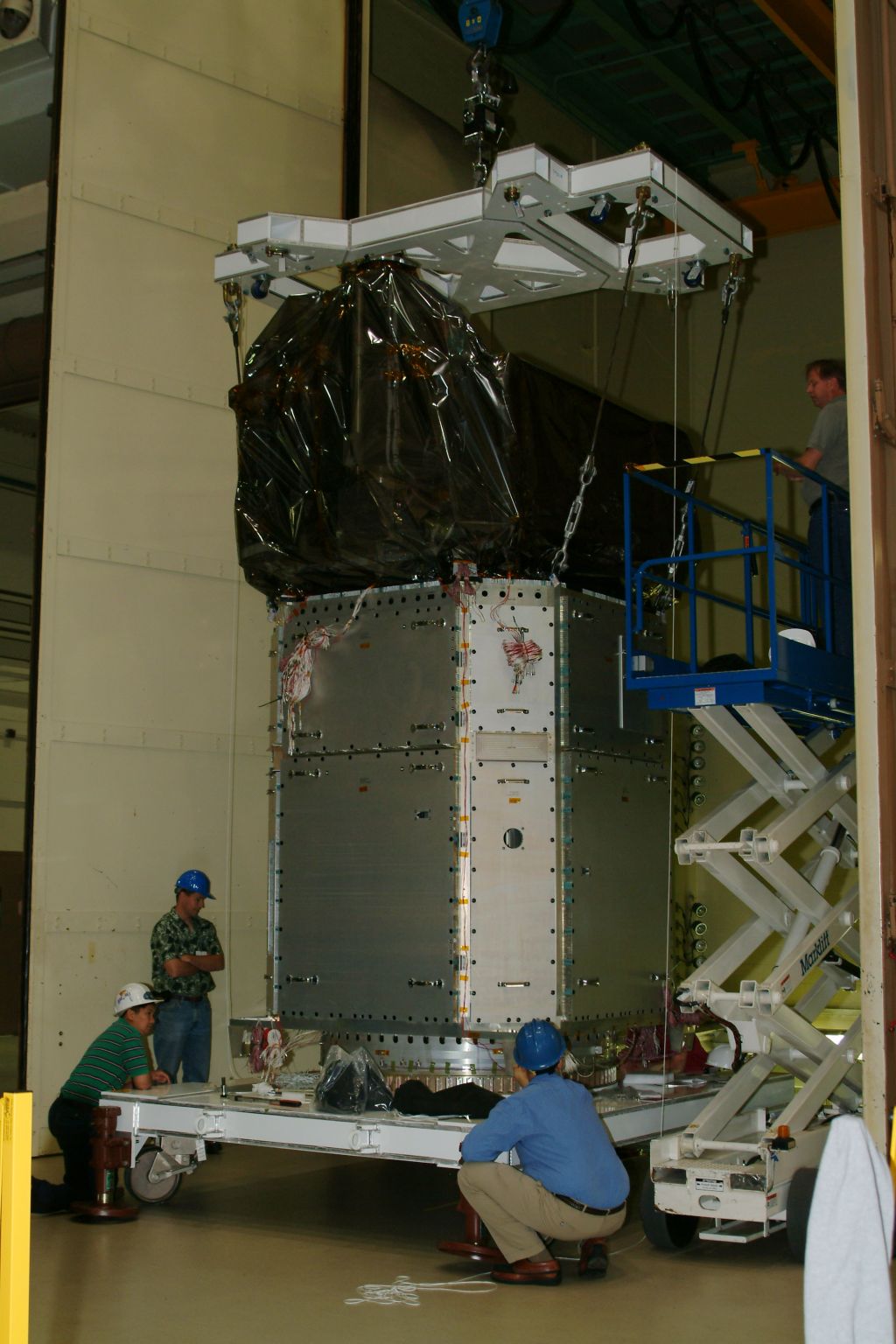
By the SEED Team with Don Cohen
In 1999, Becky Derro had been a mechanical engineer at Goddard Space Flight Center for seven years and was lead mechanical engineer on COR-1, a coronagraph that is part of the Solar Terrestrial Relations Observatory (STEREO) mission, when she decided that she wanted to try something different. “I do better in a new, scary situation,” she says. “I think it keeps you sharp.” As someone always interested in what other members of the project team were doing, she wanted to understand more about the “big picture” — how the various parts of a project fit together. Her desire for a new challenge and curiosity about the many technical aspects of a project made her a good candidate for Goddard’s newly established Systems Engineering Education Development program, known as SEED.
A “big picture” approach is the essence of systems thinking and systems engineering. Jamie Britt, a current SEED participant, explains that systems engineering looks at the interdependence of project elements, “how changes in one part of a mission ripple through to the others.” A good systems engineer, he adds, “keeps the big picture in his head.” He or she understands the technical requirements of the project as a whole and the connections or interfaces between technical elements.
Carolyn Casey, who used her knowledge of applied behavioral science to help create SEED, wanted a program that would provide the real-life expertise and experience effective systems engineers need. “There are a lot of leadership programs out there,” she says, “but not a lot of good leaders.” To make sure that the SEED curriculum would offer the learning that really matters, the program’s designers gathered a group of experts — people who actually do the job — and asked them to describe what they do and explain what is important to doing the work well. The program addresses a broad range of skills and the connections between them. “We took a systems approach to leadership development,” says Casey.
The heart of SEED is the series of hands-on project assignments participants take on during the program’s two-year span. These rotations typically last no more than six months and give participants some of the varied experience that effective systems engineers must have. This kind of learning is hard to come by if one is not in the program, since so many NASA project assignments last for years. Outside SEED, leaving a project after six months is usually a sign of failure or incompatibility.
SEED participants on these brief assignments are not just observers. “We look for great development opportunities,” says Jennifer Bracken, SEED’s program manager. The cost of the rotations comes out of project budgets, and project managers agree to them because they expect to get productive work from these able and highly motivated people, not just to provide an educational opportunity. A mentor on the project team helps SEEDlings (as they are sometimes called) quickly understand project aims and requirements and reflects with them on their experience. Mentoring is an essential part of the program, deputy program manager Carl Wales notes. Sometimes, Britt admits, you “flounder around a bit” at the beginning of a rotation until a member of the project team has time to help you, but when that help comes, you get the “aha moment” that makes it possible for you to understand what the project is about and contribute to it. At the end of each rotation, participants debrief with the SEED Advisory Board, describing what they have learned and what, in retrospect, they would have done differently.
Like Becky Derro, Evan Webb knew in the late nineties that he wanted to enlarge his experience and learn about project elements beyond his expertise in command and data handling. Before SEED existed, he was trying to find a way to rotate among projects to get that broader perspective. He was among the first to apply to the program and also became a member of the first group of SEEDlings.
These hands-on experiences teach lessons about the real–life complexities, problems, and satisfactions of project work that can never be duplicated in the classroom, and they build the kind of confidence that only comes from doing real work well. But formal classes have an important, if secondary, role in SEED. Participants take Academy of Program/Project and Engineering Leadership (APPEL) courses, locally developed classes, and university courses that teach skills essential to good systems engineering. Britt notes, “The program acts as a guidance counselor for APPEL courses,” directing SEEDlings to the ones they need. And, he says, “part of your job description is to take courses,” so you avoid the danger of becoming so buried in project responsibilities that you have no time for courses.
Derro and Webb single out a nuts-and-bolts course in how to write technical requirements as especially valuable. Webb quickly had a chance to put this skill to work as the spacecraft systems engineer on Space Technology 5 (ST-5), a project to develop and test three micro-satellites. ST-5 undertook a significant mission redesign — switching from a large to a smaller launch vehicle —in the middle of Phase C (normally the final design stage). Webb was responsible for the requirements for the constellation of three spacecraft and the science validation requirements. The insights he had received into writing technical requirements, especially about what to change and what to leave alone, made it possible to meet this redesign challenge. Many of the classroom elements of SEED also emphasize real-world know-how, featuring advice and stories of life “in the trenches” told by respected NASA veterans.
Human systems and communication skills are also an important part of the SEED program. Derro and Webb agree that the human element is the main source of project success or failure and, says Webb, “You have to deal with the different expectations of people on the team. This means effective communication, and communication is both talking and listening. You have to listen carefully to subsystems people to understand their viewpoints,” he adds. “You have to read between the lines and then ask the right questions.” Derro describes a situation in which her communications training prepared her to deal with a conflict between bickering team members. She learned that simply changing the way she talked — adjusting her voice and posture — communicated a seriousness that earned respect and made it possible for her to help resolve the problem. Dealing effectively with people means engaging with the subtle and messy human dimension of projects. Part of being a good systems engineer, says Carolyn Casey, leadership and career development manager, is knowing you cannot reduce everything to the clear-cut engineering choices and being comfortable with that ambiguity.
A technical background that gains the respect of the team and helps the systems engineer understand and evaluate technical issues is important, but the ability to ask good questions, communicate clearly, and — as always — focus on the big picture is what defines successful systems engineering. Before entering the SEED program, Derro thought a systems engineer needed to be an expert on everything, but duplicating the specialized knowledge of team members is neither possible nor desirable. In fact, Webb says, even suggesting faulty technical solutions has its value. “I come up with a lot of ideas that are wrong,” he says. In the process of explaining to the systems engineer why his proposed approach won’t work, specialized engineers clarify their own thinking. Occasionally, while trying to explain why the solution is flawed, they discover that it is possible after all and a good choice.
SEED has advanced Webb and Derro’s careers more quickly than either expected. Evan Webb was on his last rotation, on ST-5, when the mission systems engineer left for other work and Webb successfully competed to take the job. Becky Derro was at the end of her two-year SEED program when a friend and branch manager encouraged her to apply for a senior systems engineer position on a program to develop an international instrument in cooperation with the European Space Agency. Although she was younger and less experienced than other candidates, she got the job, thanks, in part, to the confidence and competence she gained from the program. A member of the selecting panel who had known her before SEED commented on how dramatically she had matured, saying, “She impressed all the interviewers with her poise, knowledge, and leadership qualities. You could really see that the SEED program had been a major influence in her development.” Derro herself has said, “SEED gave me the kick in the pants I needed to look at career development. I thought it just happened, but you have to steer it somewhere.”
Derro and Webb consider it part of their job to identify other people who they believe would be good systems engineers and encourage them to apply to the program. Not all SEED participants become systems engineers, of course. Some choose to return to their work on subsystems. Even in those cases, Carl Wales says, the program is a success, both because it helps those individuals discover that they really do prefer more focused work and because knowledge of systems engineering principles has value for every member of a project team — being aware of how a particular component relates to the whole helps ensure that the subsystem and the project will be successful.








